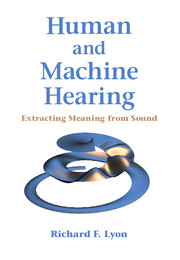Foreword
Published online by Cambridge University Press: 28 April 2017
Summary
Human and Machine Hearing is a book for people who want to understand how the auditory system and the brain process sound, how to encapsulate aspects of our hearing knowledge in computer algorithms, and how to combine the algorithms into a machine that simulates the role of hearing in some aspect of everyday life—such as listening to the melody of a song or talking to a friend in a noisy restaurant. This is what Dick Lyon means by “Machine Hearing.” The applications typically involve the segregation and identification of sound sources in everyday environments where there are competing sources and background noises—applications where there is reason to believe that the auditory form of sound analysis and feature extraction will be more effective and more robust than that provided by the traditional combination of the Fourier magnitude spectrum and MFCCs (mel-frequency cepstral coefficients). To construct a hearing machine and apply it to a real-world problem is an enormous undertaking; the latter half of the book documents the construction of a sophisticated auditory model and how it was integrated with machine learning algorithms to produce two hearing machines—an auditory search engine and an auditory melody matcher. The first half of the book describes the basic science that underpins machine hearing; it sets out the problems of constructing a stable, computationally efficient system, and it explains how to deal with each problem in turn. So the book is a comprehensive reference work for machine hearing with an ordered set of worked problems that culminate in two impressive demonstrations of machine hearing and its potential. This combination makes the book ideal both as a reference manual for experts working in the field of machine hearing and for graduate-level courses on machine hearing.
Lyon's idea of a machine hearing system has four “layers.” The first two simulate auditory frequency analysis in the cochlea and auditory image construction in the brain stem. Together they form an auditory model that is intended to simulate all of the mechanical and neural processing required to produce your initial auditory image of a sound, that is, the internal auditory representation of sound that is thought to provide the basis for perception, streaming, auditory scene analysis, and all subsequent processing.
Information
- Type
- Chapter
- Information
- Human and Machine HearingExtracting Meaning from Sound, pp. xv - xviiiPublisher: Cambridge University PressPrint publication year: 2017
